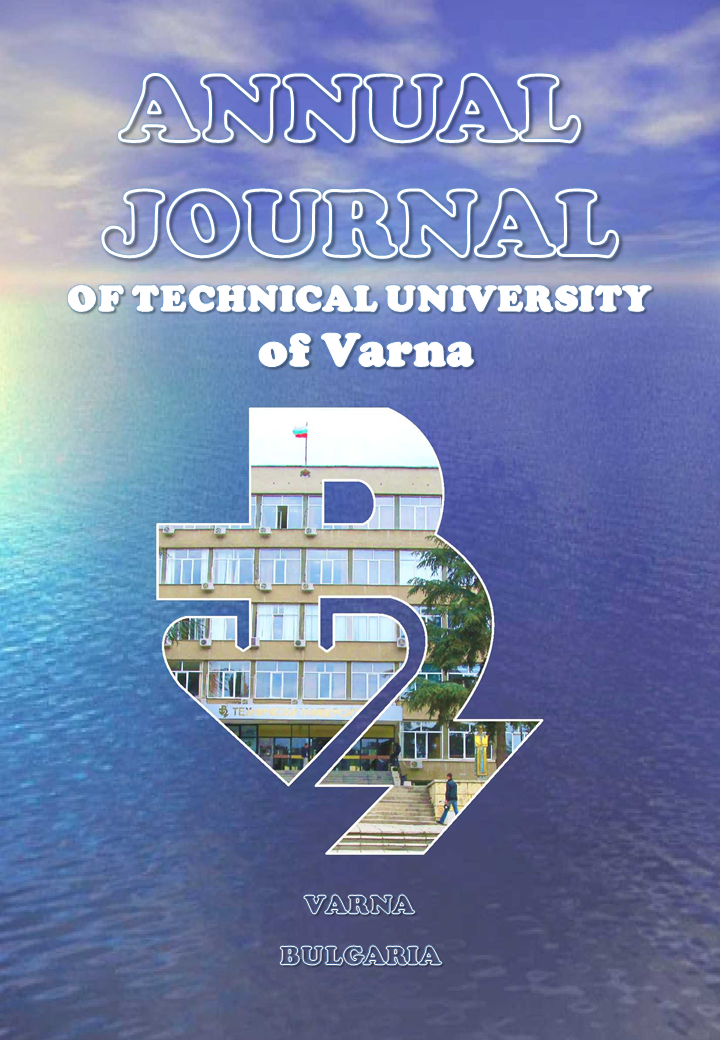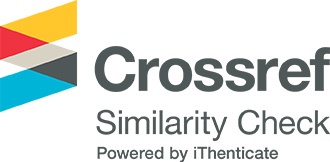Research on the effect of different types of fertilization on the maize (Zea mays L.)
##semicolon##
https://doi.org/10.29114/ajtuv.vol7.iss1.282##semicolon##
maize##common.commaListSeparator## foliar fertilization##common.commaListSeparator## yield##common.commaListSeparator## biometric parameters##common.commaListSeparator## proteinАбстракт
Maize is the cereal crop with the greatest productive potential and production in the world. A field research experiment was conducted in the field settings of the Department of "Plant Production" at the Technical University of Varna, to evaluate the effect of foliar fertilizers on the productivity and quality of Dekalb maize hybrids. Four fertilizer variants were examined and the following biometric parameters were assessed: grain yield, weight per 1000 grains, length of cob, number of rows in cob, number of grains in cob, number of grains per row, weight of grain in cob and weight of the cob. A biochemical analysis of the maize grain was performed and the content of protein, starch and fat was determined. It was established that the combined pairing of soil and foliar fertilization leads to increased productivity and enhanced biometric parameters under study, with the highest values being obtained in the variant ammonium nitrate (rate of 12 kg/dа) + 250 ml/dа NPK 2.5 SO3 with composition 3.0 N: 1.5 P: 10 K: 2.5 SO3 + 250 ml/da SO3 10% Zn, 3% N (sulfides with zinc and nitrogen). It was also ascertained, through the use of the same combination, that the maize hybrids under examination contain the highest amount of protein. Provided, from the findings of the experiment, is a conclusive evidence, that the combination of sowing soil fertilization with ammonium nitrate (rate of 12 kg/da) and two foliar fertilizers (rate of 250 ml/da) – NPK 2.5 SO3 + SO3, 10% Zn, 3% N improved the productivity and quality of the investigated Dekalb maize hybrids.
Изтегляния
##submission.citations##
<p>Amanullah, Saleem, A., Iqbal, A. & Fahad, S. (2016). Foliar Phosphorus and Zinc Application Improve Growth and Productivity of Maize (<em>Zea mays</em> L.) Under Moisture Stress conditions in Semi-Arid Climates. <em>Journal of Microbial & Biochemical Technology</em>, 8 (5), pp. 433-439. <br /><a href="https://doi.org/10.4172/1948-5948.1000321" target="_blank">Crossref</a></p>
<p>Aslam, M., Zamir, M. S. I., Afzal, I., Yaseen, M., Mubeen, M. & Shoaib, A. (2013). Drought stress, its effect on maize production and development of drought tolerance through potassium application. <em>Cercetări Agronomice în Moldova</em>, 46 (2), pp. 99-114. Retrieved from <a href="https://www.researchgate.net/publication/305471407" target="_blank">https://www.researchgate.net/publication/305471407</a></p>
<p>Brankov, M., Simic, M., Zeljko, D., Rajkovic, M., Mandic, V., & Dragicevic, V. (2020). The Response of Maize Lines to Foliar Fertilizing. <em>Agriculture</em>, 10 (9), pp. 365. <a href="https://doi.org/10.3390/agriculture10090365" target="_blank">https://doi.org/10.3390/agriculture10090365</a></p>
<p>Gerasimova, N. (2013). Effect of postemergence herbicides on yields in maize (<em>Zea mays</em> L.). <em>Scientific works of the University of Ruse</em>, Volume 52, Series 1.1, pp. 52-56 (Bg). Retrieved from <a href="https://www.researchgate.net/publication/356101791" target="_blank">https://www.researchgate.net/publication/356101791</a></p>
<p>Ivanov, M. & Dimitrov, I. (2018). Influence of some agro-technical factors on the productivity of triple crop rotation in the agro-ecological conditions of the Upper Thracian lowland. <em>Bulgarian Journal of Crop Science</em>, 55 (4), pp. 14-23 (Bg). Retrieved from <a href="https://cropscience-bg.org/page/bg-topmenu/about.php" target="_blank">https://cropscience-bg.org/page/bg-topmenu/about.php</a></p>
<p>Ivanov, M. & Dimitrov, I. (2018). Influence of some agro-technical factors on the productivity of triple crop rotation in the agro-ecological conditions of the Upper Thracian lowland. <em>Bulgarian Journal of Crop Science</em>, 55 (4), pp. 14-23 (Bg). Retrieved from <a href="https://cropscience-bg.org/page/bg-topmenu/about.php" target="_blank">https://cropscience-bg.org/page/bg-topmenu/about.php</a></p>
<p>Jakab, P., David, Z., & Komarek, F. (2017). Investigation of Foliar Fertilization in Maize Production. <em>Advanced Research in Life Sciences</em>, 1 (1), pp. 1-6. <br /><a href="https://doi.org/10.1515/arls-2017-0001" target="_blank">Crossref</a></p>
<p>Karov, St., (ed.). (2004). Basics of organic farming. <em>Bioselena Foundation</em>, pp. 50 (Bg). Retrieved from <a href="https://orgprints.org/id/eprint/30831/1/Organic_Farming_Bulgaria.pdf" target="_blank">https://orgprints.org/id/eprint/30831/1/Organic_Farming_Bulgaria.pdf</a></p>
<p>Koteva, V. & Bazitov, R. (2013). Mineral Fertilization Effect’s on Common Wheat, Cultivated in Favorable and Risky Climate Conditions. <em>Bulgarian Journal of Soil Science, Agrochemistry and Ecology</em>, Vol. XLVII, № 3, pp. 39-46 (Bg). Retrieved from <a href="https://soilscience-bg.org/page/en-topmenu/home.php" target="_blank">https://soilscience-bg.org/page/en-topmenu/home.php</a></p>
<p>Koteva, V. & Маrcheva, М. (2016). Productivity and Grain Quality of Maize, Cultivated on Pellic Vertisol without Fertilization in South-East Bulgaria. <em>New Knowledge Journal of Science, Anniversary International Scientific and Applied Conference – UARD</em>, <em>Bulgaria</em>, pp. 181-187 (Bg). Retrieved from <a href="https://science.uard.bg/index.php/newknowledge/index" target="_blank">https://science.uard.bg/index.php/newknowledge/index</a></p>
<p>Koteva, V., Kostadinova, S. & Popova, Yo. (2014). Effectiveness of Mineral Fertilization on Maize for Grain, Cultivated in Pellic Vertisol, FAO in Southeastern Bulgaria in Favorable and Risky Meteorological Conditions. <em>Bulgarian Journal of Soil Science, Agrochemistry and Ecology</em>, Vol. XLVIII, № 2, pp. 34-42 (Bg). Retrieved from <a href="https://soilscience-bg.org/page/en-topmenu/home.php" target="_blank">https://soilscience-bg.org/page/en-topmenu/home.php</a></p>
<p>Kuneva V. & Bazitov, R. (2014). Influence of fertilization on the level on the structural indexes of maize hybrid LG 35.62. <em>Scientific works of the University of Ruse</em>, Volume 53, Series 1.1, pp. 44-47 (Bg). Retrieved from <a href="https://conf.uni-ruse.bg/bg/docs/cp14/1.1/1.1-8.pdf" target="_blank">https://conf.uni-ruse.bg/bg/docs/cp14/1.1/1.1-8.pdf</a></p>
<p>Kuneva V., Kalaidzieva, R., Маtev, А., & Кirchev, H. (2015). Evaluation of the Factors Fertilization and Irrigation Regimes on the Yield of Maize Based of Mathematical-Statistical Analysis. <em>Bulgarian Journal of Crop Science</em>, 5, pp. 79-83 (Bg). Retrieved from <a href="https://www.researchgate.net/publication/286924867%20" target="_blank">https://www.researchgate.net/publication/286924867 </a></p>
<p>Mikova, A., Alexandrova, P., & Dimitrov, I. (2013). Maize grain yield response to N fertilization, climate and hybrids. <em>Bulgarian Journal of Agricultural science</em>, 19 (3), pp. 454-460. Retrieved from <a href="https://www.agrojournal.org/19/03-10.pdf" target="_blank">https://www.agrojournal.org/19/03-10.pdf</a></p>
<p>Mitova, I. & Dinev, N. (2017). Agricultural development - Conventional and/or organic? Sustainable. <em>East-West Publishing House - Sofia</em>, pp.167 (Bg). Retrieved from <a href="https://www.researchgate.net/publication/370389070_" target="_blank">https://www.researchgate.net/publication/370389070</a></p>
<p>Nikolova, М. (2018). Plant nutrition management - modern approaches. <em>Plant protection</em> (Bg), Retrieved from <a href="https://www.plant-protection.com/article/902" target="_blank">https://www.plant-protection.com/article/902</a></p>
<p>Nyagorme, D., Amoah A. & Gyapong, T. (2021). Response of maize (<em>Zea mays</em> L.) to foliar and soil applied fertilizers in the Semi-deciduous forest zone of Ghana. <em>African Journal of Agricultural Research</em>, 17 (8), pp. 1114-1122.<br /><a href="https://doi.org/10.5897/ajar2021.15561" target="_blank">Crossref</a></p>
<p>Petkova, V., Yusmen, М. & Koleva-Valkova, L. (2014). Effect of Foliar Fertilizers on Young Sunflower and Maize Plants under Nitrogen Deficiency. <em>Agricultural University – Plovdiv, Scientific Works</em>, vol. LVIII, pp. 241-248 (Bg). Retrieved from <a href="http://nauchnitrudove.au-plovdiv.bg/28-" target="_blank">http://nauchnitrudove.au-plovdiv.bg/28</a></p>
<p>Todorova, S., Trendafilov, K. & Valcheva, V. (2013). Differentiation of fertilization rates with phosphorus and potassium based on geospatial data for their reserves in soil. <em>Scientific papers series a. agronomy</em>, vol. LVI, pp. 126-132. Retrieved from <a href="https://www.yumpu.com/en/document/view/28043732/scientific-papers-series-a-agronomy" target="_blank">https://www.yumpu.com/en/document/view/28043732/scientific-papers-series-a-agronomy</a></p>
<p>Todorova, S., Simeonova, N., Trendafilov, K. & Valcheva, V. (2012). Change of available forms of nitrogen and phosphorus in alluvial-meadow soil, after long-term fertilization. <em>Agricultural Science and Technology</em>, vol. 4, pp. 388-391. Retrieved from <a href="https://agriscitech.eu/" target="_blank">https://agriscitech.eu/</a></p>
<p>Toncheva, R. (2016). Investigation the Productivity of Maize in Different Agroecological Conditions, Fertilization and Plant Density I. Non-Irrigated Conditions. <em>Bulgarian Journal of Soil Science, Agrochemistry and Ecology</em>, 50, 2, pp. 50-59 (Bg). Retrieved from <a href="https://soilscience-bg.org/page/en-topmenu/home.php" target="_blank">https://soilscience-bg.org/page/en-topmenu/home.php</a></p>
<p>Toungos, M.D., Bamai, N. & Yamma, K.M. (2016). Effects of Combined Application of NPK and Foliar Fertilizer (Boost-Extra) On Yield and Yield Components of Maize (Zea mays L.) In Mubi, Northern Guinea Savannah Zone of Nigeria. <em>International Journal of Innovative Agriculture & Biology Research,</em> 4 (3), pp. 17-25. Retrieved from <a href="http://www.seahipaj.org/" target="_blank">http://www.seahipaj.org/</a></p>
<p>Traykov, N., Toncheva, R. & Dimitrov, I. (2017). Investigation of the productivity of maize depending on agro-ecological conditions and applied agrotechnics. <em>Bulgarian Journal of Soil Science, Agrochemistry and Ecology</em>, 51, 1, pp. 12-24 (Bg). Retrieved from <a href="https://soilscience-bg.org/page/en-topmenu/home.php" target="_blank">https://soilscience-bg.org/page/en-topmenu/home.php</a></p>
##submission.downloads##
Публикуван
##submission.howToCite##
Брой
Раздел (Секция)
##submission.license##
СПОРАЗУМЕНИЕ ЗА ПУБЛИКУВАНЕ
Годишника на Технически университет - Варна (ГТУВ) цели да гарантира, че постъпващите статии се публикуват, като същевременно се предоставя значителна свобода на публикуващите ги автори. За изпълнение на тази цел, ГТУВ поддържа гъвкава политика относно авторските права, което означава, че няма прехвърляне на авторски права от автора на издателя, а авторите запазват изключително авторско право върху интелектуалното си произведение.
При изпращане на статия, Отговорния автор трябва да се съгласи и приеме правилата и условията за публикуване, изложени в настоящото Споразумение за публикуване, които са както следва:
ПРЕДОСТАВЯНЕ НА ПРАВА ОТ ОТГОВОРНИЯ АВТОР
Отговорния автор предоставя на ГТУВ за времето на пълния срок на авторското право и всяко следващо удължаване или подновяване, следното:
• Неотменимо, неизключително право да публикува, възпроизвежда, предоставя, разпространява или по друг начин използва предоставената работа в електронни и печатни издания и в производни произведения в целия свят, на всички езици и във всички известни съществуващи или в последствие възникнали медии.
• Неотменимо, неизключително право да създава и съхранява електронни архивни копия на работата, включително правото да депозира предоставената работа в дигитални хранилища с отворен достъп.
• Неотменимо, неизключително право на лицензиране на други лица да възпроизвеждат, превеждат, преиздават, предоставят и разпространяват предоставената работа при условие, че авторите са надлежно идентифицирани (за момента това се извършва чрез публикуване на произведението под лиценз Creative Commons Attribution 4.0 Unported).
С предоставянето на работата за публикуване, авторските права върху материала остават на авторите. Авторите запазват всички патентни, търговски марки и/или други права върху интелектуалната си собственост.
ЗАДЪЛЖЕНИЯ НА ОТГОВОРНИЯ АВТОР И СЪАВТОРИТЕ
При последващо разпространение или повторно публикуване на предоставената работа, Отговорния автор се съгласява да идентифицира ГТУВ, в който е публикувано произведението като първоначален източник на първото публикуване на работата. Отговорния автор гарантира, че съавторите също ще посочват ГТУВ като източник на първото публикуване, когато разпространяват, преиздават или се позовават на настоящата работа в бъдещи свои публикации.
ГАРАНЦИИ ОТ СТРАНА НА ОТГОВОРНИЯ АВТОР
Отговорния автор гарантира че предоставената за публикуване работа не нарушава никои действащи нормативни разпоредби или законни права на която и да е трета страна. Същия гарантира че работата не съдържа какъвто и да е материал, който може да се възприеме от читателската аудитория като неетичен, компрометиращ, нехуманен, расистки, клеветнически и/или нарушаващ авторски и/или имуществени права, права на интелектуална собственост или поети ангажименти за поверителност към трети страни. Отговорния автор гарантира че предоставеният материал е с оригинално съдържание, не е официално публикуван в никое друго издателство, както и че не е в процес на публикуване пред други издателства. Отговорния автор също така гарантира че притежава съответните правомощия да сключи настоящото споразумение. Ако предоставяната работа е подготвена съвместно с други съавтори, Отговорния автор гарантира че всички останали съавтори са информирани и са съгласни предоставения материал да бъде публикуван в ГТУВ.
Отговорния автор лично (или от името на авторския колектив) дава съгласието си да не въвлича по никакъв начин ГТУВ като страна в каквито и да било научни, академични, административни и/или съдебни спорове, в случаите на установени нарушения на горепосочените декларации и гаранции.
ПРАВА И ЗАДЪЛЖЕНИЯ НА ГТУВ
ГТУВ се съгласява да публикува предоставения материал, в случаите когато същия отговаря напълно на всички необходими качествени, технически и редакционни изисквания, като го идентифицира еднозначно с авторите му. В следствие на настоящото споразумение, на ГТУВ се предоставя правомощие да упражнява права при необходимост от името на авторите върху трети лица, като например в случаите на установено плагиатство, нарушаване на авторски права и др.
Декларация за поверителност на лични данни
Вашите имена и имейл адреси, въведени в уебсайта на ГТУВ, ще бъдат използвани само и изключително за обявените цели на настоящото списание и няма да бъдат използвани за никакви други цели от издателя или предоставяни на друга - трета страна.
Издателят се задължава да извърши всички необходими действия, цялата предоставена лична информация да остане конфиденциална, в рамките на издателя и да не бъде споделена с външни обекти или субекти, освен ако не е дадено предварително изрично разрешение от собственика на личните данни.
Вашата лична информация няма да бъде обект на продажба, разпространение или публикуване по какъвто и да е начин и под каквато и да е форма.









